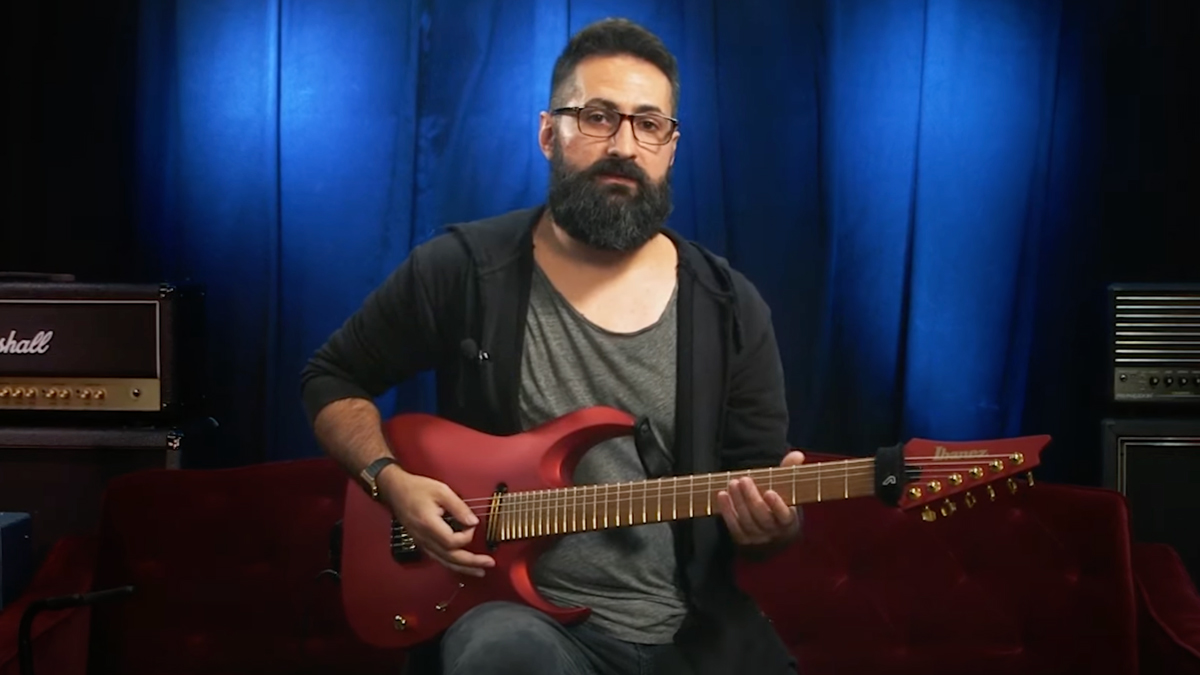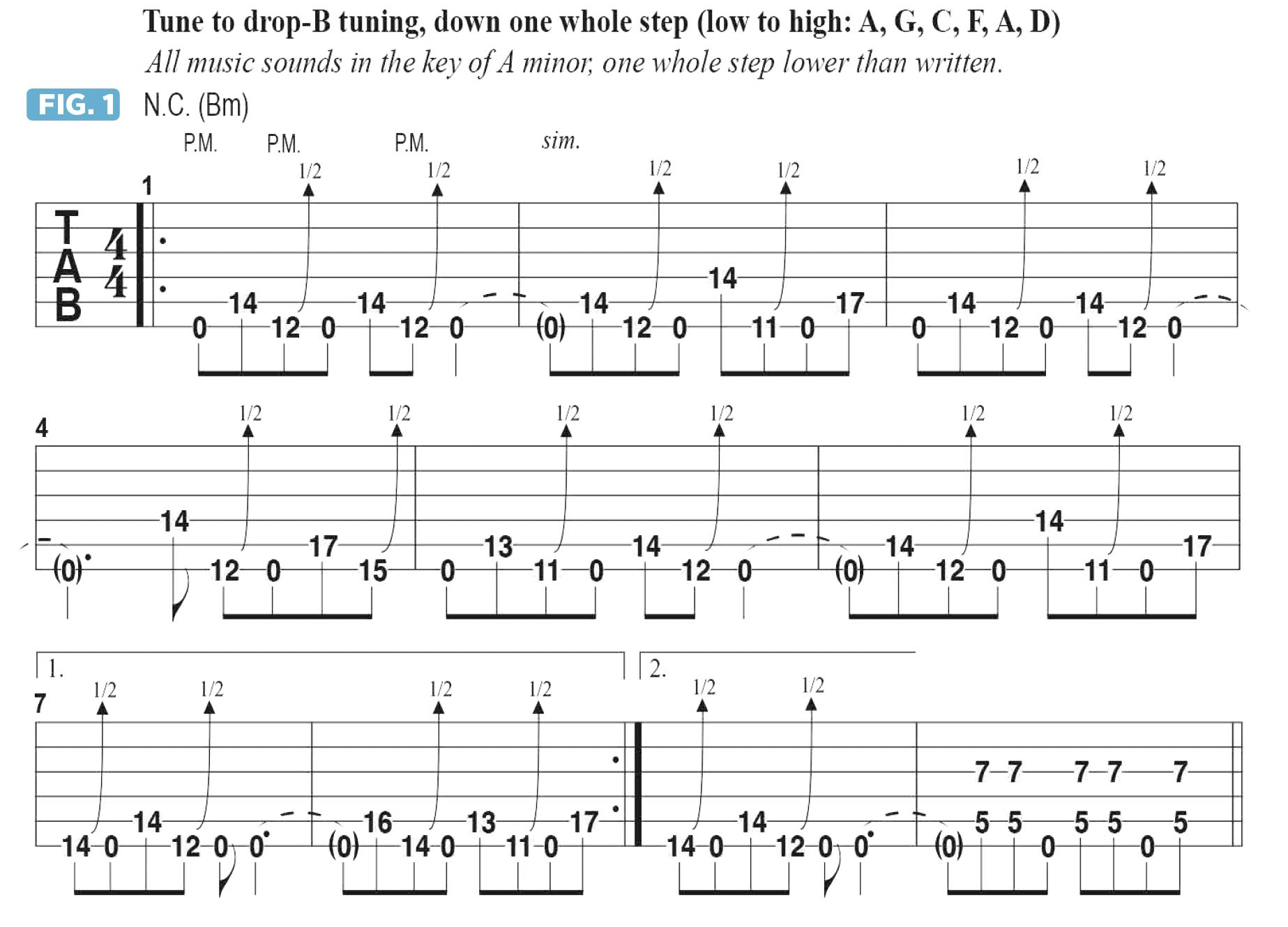How to use drop tunings, octave effects and layered tones to create a deep, huge sound
In his latest GW column, Jake Bowen walks us through the massive intro riff for Periphery's Follow Your Ghost

Today I'd like to talk about some effective ways that you can reinforce your rhythm guitar tone when recording, by double-tracking parts and utilizing unusual tunings, octave pedal effects and split-coil tones. To illustrate, I will cite the intro riff I wrote and recorded for the Periphery song Follow Your Ghost, from Periphery IV: Hail Stan.
I play this song on a 6-string guitar that’s tuned to what many players refer to as drop-A, which is drop-B tuning (low to high: B, A, D, G, B, E), transposed down a whole step. So, low to high, the strings are tuned to A, G, C, F, A, D.
An interesting thing about this tuning is that it puts your bottom two strings almost an octave apart, specifically a minor 7th interval – B up to A. So if you finger what looks an feels like a regular two-note, root-5th power chord shape on these strings, the two notes are actually an octave apart. It’s like playing a 7-string guitar with a low B string but without a low E.
As a lot of guitarists are inclined to do when transposing a tuning down a half step, whole step, minor 3rd, etc., I prefer to not acknowledge the pitch transposition and instead just think of, visualize and refer to the notes “normally”, meaning as if I were playing in a “regular” tuning, which in this case would be drop-B.
So even though my 6th string is tuned down to A, I’ll still think of it as “B,” and I’ll think of the 5th string as my “A” string, even though it’s tuned to G. And the same with any fretted notes on any of the strings.
When tracking our rhythm parts, my Periphery co-guitarists Misha Mansoor and Mark Holcomb and I usually like to double-track each of our individual parts and pan the two tracks hard left and right. Figure 1 illustrates the main riff from Follow Your Ghost, which I tracked this way.
As you’ll see in bar 1, the open low B note (which is actually A at concert pitch) is played alternately against a B note two octaves higher, located on the A string’s 14th fret. In between these double-octave B notes, I add an additional B that’s only one octave above the open low B, played at the 12th fret on that string.
Every time I fret this note here, I’ll bend it up slightly, approximately a half step, which lends the riff a haunting, demonic quality. When bending your lowest string like this, you have no choice but to pull it in toward the middle strings, as pushing the string upward, using the more common push-bending technique, would cause it to fall off the side of the fretboard “cliff.”
In bar 2, I repeat the first two beats from bar 1 then veer off in a different direction and add a high E note on the D string’s 14th fret, followed by A# at the 11th fret on the low B string. Bar 3 is a restatement of bar 1, and in bar 4, I allow the open low B note to ring through the first one and one half beats, followed by the high B note on the A string’s 14th fret and the “middle B” at the 12th fret on the bottom string.
I end the bar by reaching up to D at the 17th fret on the A string followed by D an octave lower, at the 15th fret on the bottom string, again using what looks like a conventional power chord fingering shape that I’m shifting around the fretboard.

In bar 5, the riff becomes more “warped,” as I include more of the A# notes at the 11th fret on the bottom string, which I similarly bend up a half step. The first eight-bar section ends with C# octaves at the 14th and 16th frets on the bottom two strings, followed by a shift down to A# octaves at the 11th and 13th frets.
The initial six bars then repeat, and the entire form ends in the final two bars with strummed octaves on D, fretted on the A and G strings down in 5th position, using the conventional octave shape on non-adjacent strings and played in a syncopated rhythm against the open low B note. Throughout the riff, the focus is on the subtle shifts in rhythmic syncopation, with the emphasis changing from the downbeats to the eighth-note upbeats.
When recording this song, I additionally tracked different pairs of left and right rhythm guitars that are treated with a sub-octave effect with a wet/dry mix, and I also utilized pickup coil-tapping to add some single-coil “snap” to the overall tone. Ultimately, I think I achieved a wide, multi-dimensional sound while playing what’s essentially the same rhythm part throughout.
Get The Pick Newsletter
All the latest guitar news, interviews, lessons, reviews, deals and more, direct to your inbox!
“There are so many sounds to be discovered when you get away from using a pick”: Jared James Nichols shows you how to add “snap, crackle and pop” to your playing with banjo rolls and string snaps
Don't let chord inversions bamboozle you. It's simply the case of shuffling the notes around







![Joe Bonamassa [left] wears a deep blue suit and polka-dotted shirt and plays his green refin Strat; the late Irish blues legend Rory Gallagher [right] screams and inflicts some punishment on his heavily worn number one Stratocaster.](https://cdn.mos.cms.futurecdn.net/cw28h7UBcTVfTLs7p7eiLe.jpg)


